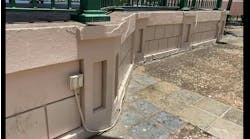How well do you know the Code? Think you can spot violations the original installer either ignored or couldn’t identify? Here's your chance to moonlight as an electrical inspector and second-guess someone else's work from the safety of your living room or office. Can you identify the specific Code violation(s) in this photo? Note: Submitted comments must include specific references from the 2020 NEC.
Hint: Outdoor receptacle debacle
Tell Them What They've Won…
Using the 2020 NEC, correctly identify the Code violation(s) in this month's photo — in 200 words or less — and you could win an Arlington Industries 18" Slider Bar and plastic box for mounting between studs with non-standard spacing. E-mail your response, including your name and mailing address, to [email protected], and Russ will select three winners (excluding manufacturers and prior winners) at random from the correct submissions. Note that submissions without an address will not be eligible to win.
May Winner
Our lone winner this month is Kevin Redman, an EC&M reader from Escondido, Calif. Kevin knew that a service disconnect cannot be mounted this high. Having a meter socket mounted up high adjacent to a second-floor window is not a violation. But mounting a meter socket enclosure having an integral main breaker at this height is a violation. Section 230.70 requires the service disconnecting means to be installed at a readily accessible location. The definition in Art. 100 for “readily accessible” does not specify a maximum height, but needing a portable ladder to reach the disconnect proves it is not readily accessible. Section 240.24(A) requires circuit breakers and fused switches to be readily accessible and installed so the operating handle (in its highest position) is no more than 6 ft 7 in. above the floor or working platform. The breaker in this enclosure is probably 12 ft to 15 ft high. Another problem is the conductor drip loops appear to be too close to the window. Section 230.9 requires open conductors to have a clearance of 3 ft from windows designed to open.





